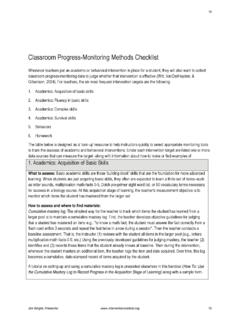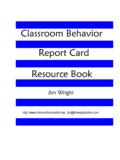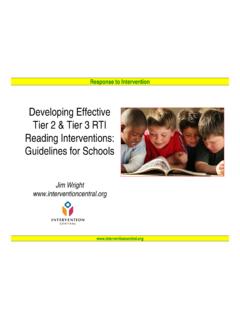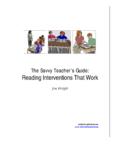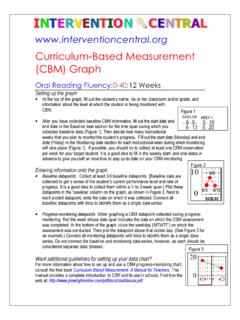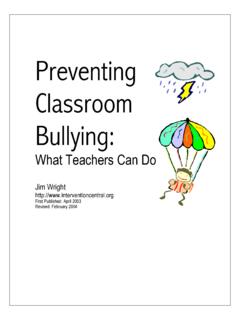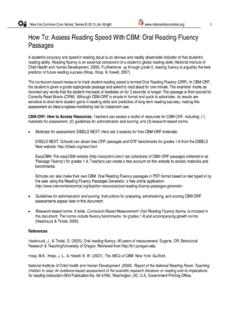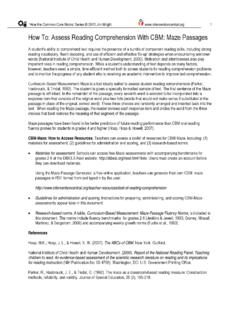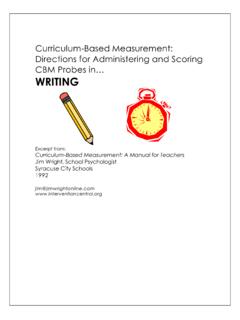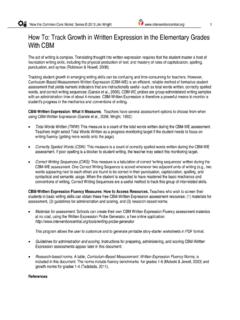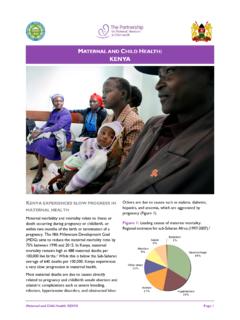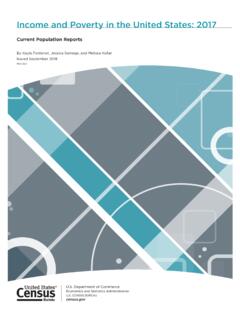Transcription of Curriculum-Based Measurement: A Manual for Teachers
1 Curriculum-Based measurement : A Manual for Teachers Jim Wright Syracuse (NY) City Schools Chapter 1: Introduction to Curriculum-Based MeasurementCBM Workshop Manual Jim Wright Page 1-1 1 An Overview of Curriculum-Based MeasurementIntroductionA major responsibility of schools is to teach children the academic skills thatthey will eventually need to take their place as responsible members of society.
2 Butschools not only teach crucial academic skills, they are also required to measure individual children 's acquisition and mastery of these skills. The measurement of achild's school abilities is just as important as the teaching of those skills. After all,only by carefully testing what a child has learned can the instructor then drawconclusions about whether that student is ready to advance to more difficultmaterial. In the past, routine classroom testing has often involved the use ofcommercially prepared tests.
3 These tests have significant limitations, as we shallsoon see. An alternative approach to academic assessment has recently becomeavailable, however, that allows Teachers to closely monitor the rate of studenteducational progress. Educational researchers have devised a simple, statisticallyreliable, and practical means of measuring student skills in basic subject areas suchas reading, writing, and arithmetic. In this approach, called curriculum -basedmeasurement, or CBM, the student is given brief, timed exercises to complete, usingmaterials drawn directly from the child's academic program.
4 To date, Teachers usingCBM have found it to be both a powerful assessment tool for measuring mastery ofbasic skills and an efficient means of monitoring short-term and long-term studentprogress in key academic areas. This Manual has been designed for use in a CBM teacher -training you have completed the course, you will be able to use CBM independentlyto monitor the academic skills of children in your classroom. You will be trained togive CBM probes, chart the resulting data, and consult charted CBM informationcollected over time to make decisions about the effectiveness of instructionalinterventions.
5 The remainder of the present chapter provides answers to questionsthat educators commonly ask about Curriculum-Based : What is Curriculum-Based measurement ?A: Curriculum-Based measurement , or CBM, is a method of monitoring studenteducational progress through direct assessment of academic skills. CBM can be usedto measure basic skills in reading, mathematics, spelling, and written expression. Itcan also be used to monitor readiness skills. When using CBM, the instructor givesthe student brief, timed samples, or "probes," made up of academic material takenfrom the child's school curriculum .
6 These CBM probes are given under standardized conditions. For example,Chapter 1: Introduction to Curriculum-Based MeasurementCBM Workshop Manual Jim Wright Page 1-2the instructor will read the same directions every time that he or she gives a certaintype of CBM probe. CBM probes are timed and may last from 1 to 5 minutes,depending on the skill being measured. The child's performance on a CBM probe isscored for speed, or fluency , and for accuracy of performance. Since CBM probes arequick to administer and simple to score, they can be given repeatedly (for example,twice per week).
7 The results are then charted to offer the instructor a visual recordof a targeted child's rate of academic progress. Q: What are the drawbacks of traditional types of classroom testing?A: Traditional academic testing methods often rely on norm-referenced tests are developed by testing companies to be used in schoolsacross the country. While these traditional academic achievement tests can yielduseful information in some situations, they also have several significant drawbacks: Normed to a national "average"First, to ensure that their tests can be used by schools across the country, mosttesting companies set the performance standards for their academic achievementtests according to a national average.
8 However, as every teacher knows, the averageskill levels in a particular classroom or school may vary a great deal from nationalaverages. As a result, information from norm-referenced tests will probably notgive the instructor a clear idea of what the typical skill-levels might be in his or herown of overlap with local, or classroom, curriculumAlso, because norm-referenced tests are designed to measure skills across anational population, the skills that they measure will not completely overlap thoseof the local classroom curriculum .
9 Over the course of several months, for example,one student may gain skills in certain math computation problems that are notmeasured on a particular achievement test. The test information might thenmislead a teacher into believing that a child has made less progress than is actuallythe infrequentlyIn addition, norm-referenced tests cannot be given very often to determinestudent academic progress. Teachers who depend on these tests usually have to waita number of months before they can learn whether a student is really benefitingfrom an academic program.
10 Less sensitive to short-term academic gainNorm-referenced tests are not very sensitive to short-term gains in schoolskills. As a result, a teacher who relies solely on these tests to judge student growthmay miss evidence of small, but important, improvements in a child's academicChapter 1: Introduction to Curriculum-Based MeasurementCBM Workshop Manual Jim Wright Page : What are the advantages of CBM over other testing methods?A: In contrast to norm-referenced academic achievement tests, CBM offers distinctadvantages.
